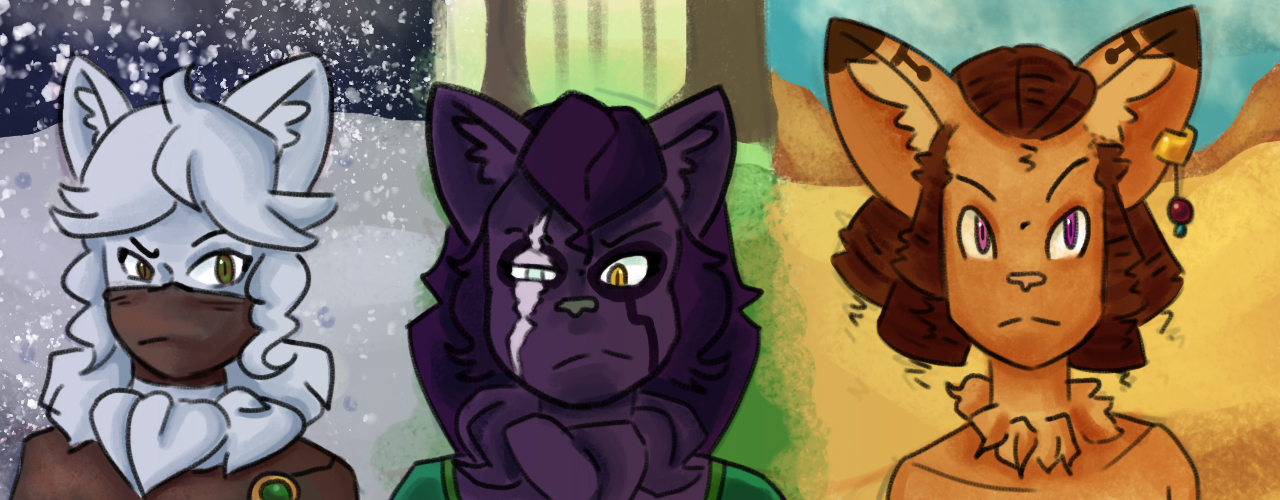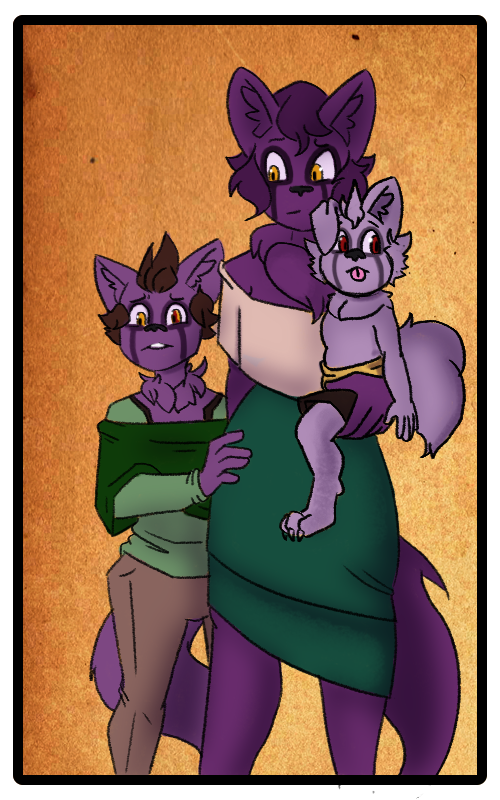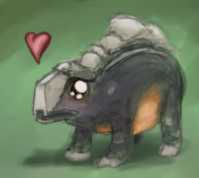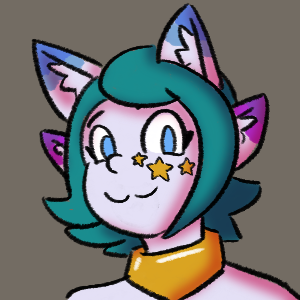Bloodkeeper
About
Bloodkeepers are a demon species, made for hunting in small packs and living in large communal groups.Their territories span from lush forests, snowy tundras, and blistering deserts. Each of these locals affect how Bloodkeepers appear, and changes their culture.
The species, true to their namesake--consume minimal blood during rituals, customs, or other circumstances. They are a Mana attuned species and with their blood consumption, intake some of the Mana within it. This is usually saved for prey they have hunted, as Bloodkeepers use this to give thanks for the life lost to give them sustenance.
Bloodkeepers are wary of humans, the only ones that are somewhat used to them are ones that have moved into human settlements. Both Bloodkeepers and humans have a wary relationship with one another, see The Bloodkeeper War for more information.
Appearance
When Bloodkeepers are born, their fur is snow white. Depending on the location of the tribe, this will affect what the final colour of their fur will be. Their fur colour changes based on the amount of blood--and therefore mana-- that is consumed.
Forest Bloodkeepers' fur becomes purple, sometimes with a tint of green when more blood is consumed.Desert Bloodkeepers usually have red or orange tinted fur. Tundra Bloodkeepers are an exception, and do not consume as much blood as their Forest and Desert counterparts; instead consuming a drop of blood every year they are alive.Tundra Bloodkeepers will have the white fur they are born with, with a tinge of silver or light blue.
Their fur will eventually become black if enough blood is consumed, and is considered an honourable thing for Forest Bloodkeepers. Desert Bloodkeepers prefer to keep their fur light to avoid overheating; if they do get their fur dark, they avoid going out when the sun is up.
Tundra Bloodkeepers will shun and exile Bloodkeepers with black fur, as they consider it a lack of restraint given their snow covered homes.
Markings
Markings are an important cultural symbol to Bloodkeepers, as it allows other tribes to know family relations at a glance. To obtain these markings, Bloodkeepers's fur is stained with heavy dye, which is re-applied every year in a celebration of their birth.
Each community displays the marking in a different area, some examples can be seen below. These are not the only way the markings can appear, but are a general guide.
Desert Bloodkeepers
Desert Bloodkeepers place their markings on the tip of their ears, wrapping around to the back of them as well.
Their markings are usually not as dark as other Bloodkeepers.
Their markings are usually not as dark as other Bloodkeepers.
Tundra Bloodkeepers
Tundra Bloodkeepers put their markings along their arms, which are usually covered.
They do not mark their face as they try their best to stay heavily camouflaged.
They do not mark their face as they try their best to stay heavily camouflaged.
Forest Bloodkeepers
Forest Bloodkeepers place their markings on their faces, usually around their eyes and cheeks.
They are usually very open about their family symbols.
They are usually very open about their family symbols.
Bloodkeeper Eye Colour
Bloodkeepers have the same variety in eye colour as other humanoid species, though they have their own probability of the colour occurring. There are some cultural connections to eye colours, the rarer colours toeing the line between a sign fortune or a sign of disease. They vary from Common to Rare (from left to right) and will be discussed below.
- Common: Red and Gold. Most Bloodkeepers are born with these eye colours.
Uncommon: Green, Brown, and Hazel. Bloodkeepers are occasionally born with these colours, though they are considered unfamiliar, especially Hazel.
Rare: Blue and Purple. Few Bloodkeepers are born with these eye colours, and more often than not it's a sign of incredible magic, as well as an indicator of blindness of deafness in the future.
Heterochromia & Partial Heterochromia
Heterochromia and Partial Heterochromia colours still follow the same chart as the above, but it is more common for Bloodkeepers to have colours in the same category such as heterochromia with Red and Gold, or Brown and Green.
Magic
Bloodkeepers are a very hardy species, able to learn most magic with plenty of study and magical aids. They can be born in one of three affinities, based on the location of their birth. Darkness is the more common alignment, while Ice and Fire follow behind. Fire and Ice are the alignments of Bloodkeepers from Deserts and Tundras, respectively.
All Bloodkeepers are able to learn the three alignments with little difficulty, though one will always be their main source of magic. It isn't strange to see them wearing jewelry or items to help them with other types of magic.
It is believed in their culture that all creatures have Mana within them, and drinking some of a beings blood gives them a bit of the target's magic ability. It is not bizarre for Bloodkeepers to consume a drop of blood from respected peers in an attempt to have some of their innate skill.
Magic Affinity
| Species | Earth | Air | Fire | Water | Light | Dark | Lightn. | Ice |
|---|---|---|---|---|---|---|---|---|
| BloodKeeper | 2 | 2 | 0/1 | 2 | 4 | 0/1 | 3 | 0/1 |
Note: Table indicates the difficulty for each species to learn the elements. 0 = born into, 1-3 = simple to difficult, 4 = extremely difficult.
Healing Abilities
Bloodkeepers have a bizarre component to their saliva, which is able to help seal and heal minor injuries. This ability is not able to help with any major injuries such as amputation, internal bleeding, or deep stab wounds.
It is not uncommon for Bloodkeepers to literally retreat and lick their wounds after battle, and if a Bloodkeeper has a non-Bloodkeeper ally they may look after their small wounds as well. Whether it is a lick, or spitting and rubbing it into the wound. However, most will avoid spitting directly on a non-Bloodkeeper's wound, knowing that most react with disgust or misunderstanding if they are not well aware of the healing ability.
Brief History
The BloodKeeper War
The BloodKeeper War was an event 200 years prior to the current date, wherein Humans and Bloodkeepers fought for two and a half years. Near the end of the war, Bloodkeepers were hunted cruelly, almost to extinction. The animosity between humans and Bloodkeepers is still current, given the demons's lifespan.
The War also started Bloodkeeper's consumption of human blood, when before they had never consumed it. More information can be found in the Isidoro Timeline when completed, and will be linked here in the future.
This event is what caused a separation between Bloodkeepers and their belief in Devishtari and started their worship of Silence.
Basic Information
Anatomy
Bloodkeepers are a humanoid species, bipedal and digitigrade. They have features similar to vulpines such as their ears, tail, and feet;Their legs appear humanoid until the ankle joint, where they become more similar to a wolf or a fox.
All Bloodkeepers have manes and neck ruff, though males tend to have shorter fur. Male features in general are smaller, especially ears and tail fluffiness.
Unrelated to gender, claws and teeth are an important part of a Bloodkeepers physical form, capable of causing great harm if not maintained. They often file their claws.
All Bloodkeepers have manes and neck ruff, though males tend to have shorter fur. Male features in general are smaller, especially ears and tail fluffiness.
Unrelated to gender, claws and teeth are an important part of a Bloodkeepers physical form, capable of causing great harm if not maintained. They often file their claws.
Growth Rate & Stages
Bloodkeepers are a long lived race, though their first few decades of life are spent growing rapidly, similar to humans. Once they reach maturity, their aging slows down. Their life can be broken down into the following:
Birth and Youth
Bloodkeepers are born dependant on their familes for the first decade of their lives. They grow into their ears around this time, and their tails are no longer equal to their size, they are no longer awkwardly shaped.Adolescence
Adolescent years for Bloodkeepers range from 16 years to 50 years.While they've grown into their ears and tails, they now begin to go through their second growth spurt. In this period, their impulse control and maturity are similar to a human teenager.Adulthood
Bloodkeepers are considered adults once they reach their 50th year, until their 200th year. Now fully mature, they're able to start their own families, similar to a human in their early 20s.Late Life
Bloodkeeper's general life span ranges from 300 to 400 years, with 400 being rarer to reach. Once a Bloodkeeper has hit 350 years, they are considered Elderly and are usually taken care of by their family and the tribe.Ecology and Habitats
Bloodkeepers are known to create tribes in three main areas, which affects their fur colour and general build.
Forest
Forest Bloodkeepers will create villages within densely wooded areas, creating houses out of lumber, stone and more. Occasionally some will carve out trees, or have suspended homes up in the treeline.Desert
Desert Bloodkeepers will create villages in the shadows of large canyons, or tunneled underground by generations of Bloodkeepers before them. Most are made of mud-bricks, or tents with wood and animal skins.Tundra Tundra Bloodkeepers will create homes out of whatever they can scavenge, often boulders, animal skins and wooden supports to create tents. It is common for them to dig out floors, and build tents on top.They also make homes out of ice magic in the colder seasons.
Dietary Needs and Habits
Bloodkeepers are Hunter-Gatherers. They hunt in small packs, though larger packs will be made to take down bigger targets, such as moose. They will use bow and arrows, as well as traps. Bloodkeepers are raised to be as humane as possible.
They will scavenge everything they can from their kills from furs, bones, meat, as well as blood.
Bloodkeepers will share food between families during certain cultural events, or during extreme weather. Most will store their food within designated food caches within their home, or in a communal food cache.
They will scavenge everything they can from their kills from furs, bones, meat, as well as blood.
Bloodkeepers will share food between families during certain cultural events, or during extreme weather. Most will store their food within designated food caches within their home, or in a communal food cache.
Additional Information
Perception and Sensory Capabilities
Strong sense of smell, sight, and hearing; incredible sense of balance; See Magic Section
Civilization and Culture
Beauty Ideals
A shiny, well took care of fur coat is important to Bloodkeepers, and is considered incredibly attractive. Well kept manes are important as well.
The fluffier a female's coat is, the more attractive she is considered. The sleeker a male's coat and body is, the more attractive he is considered.
The fluffier a female's coat is, the more attractive she is considered. The sleeker a male's coat and body is, the more attractive he is considered.
Gender Ideals
Female Bloodkeepers are expected to be smaller, with larger features-- especially their ears and tails.
Male Bloodkeepers are expected to be slim, but still built. Their features are expected to be smaller. Etc. If a male has large ears, he is considered feminine.
Male Bloodkeepers are expected to be slim, but still built. Their features are expected to be smaller. Etc. If a male has large ears, he is considered feminine.
Major Language Groups and Dialects
Bloodkeepers are known to speak many languages, but their primary languages are Demon, and Common.
Common Customs, Traditions and Rituals
General Customs
Birthday Celebrations
Every year on the day of their birth, Bloodkeepers will have their fur dyed with the marking of their family. They will also drink the blood from an animal sacrifice.The Blood Oath
A demonic ritual used to create promises that last a lifetime, bound through blood.For more in depth information about the Blood Oath please click here.
Tundra Customs
Birthday Celebrations
Tundra Bloodkeepers abstain from drinking blood like their other biome counterparts, and while obtaining their marking they will consume their one drop of blood for the year.Interspecies Relations and Assumptions
Bloodkeepers & Dragons
Dragons and Bloodkeepers have a very good relationship with one another.They often share land and resources, and are known to have many mutually beneficial treaties and agreements.Both are looked at warily by humans, and as a result have a tight bond and understanding with each other. They will often back each other up if humans begin to cross boundaries with the other.
Bloodkeepers & Humans
Bloodkeepers and Humans currently have a tense relationship, given they are both recovering from the aftermath of a war. Bloodkeepers are looked at with scorn by most Humans, or are at least feared by them. Bloodkeepers are now given special land rights, so that their tribes are separated from most Human civilizations.
Genetic Ancestor(s)
Scientific Name
Homo ferus / Homo sacramentis
Origin/Ancestry
Demon
Lifespan
300-400 yrs
Average Height
Females: 5' 5"
Males: 5'10"
Males: 5'10"
Average Weight
Females: 149 lbs
Males: 195 lbs
Males: 195 lbs



![Bloodkeeper Markings [Desert]](/uploads/images/75c3480f314a8185e43733809a8f4240.png)
![Bloodkeeper Markings [Tundra]](/uploads/images/5b4e382e806378f2be463b8ed92d6c44.png)
![Bloodkeeper Markings [Forest]](/uploads/images/c1eec184d9499b669b78dab05adcf006.png)







Amazingly good work! Beautiful crafted article
World Anvil Founder & Chief Grease Monkey
Twitter | World Anvil Changelog
“No act of kindness, no matter how small, is ever wasted.” - Aesop
Thank you so much! I'm glad you think so.